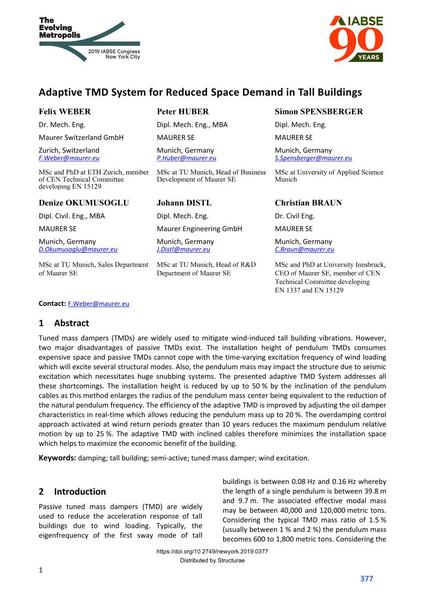Adaptive TMD System for Reduced Space Demand in Tall Buildings

|
|
|||||||||||
Bibliographic Details
| Author(s): |
Felix Weber
(Maurer Switzerland GmbH)
Peter Huber (Maurer SE) Simon Spensberger (Maurer SE) Deniz Okumusoglu (Maurer SE) Johann Distl (Maurer Engineering GmbH) Christian Braun (Maurer SE) |
||||
|---|---|---|---|---|---|
| Medium: | conference paper | ||||
| Language(s): | English | ||||
| Conference: | IABSE Congress: The Evolving Metropolis, New York, NY, USA, 4-6 September 2019 | ||||
| Published in: | The Evolving Metropolis | ||||
|
|||||
| Page(s): | 377-383 | ||||
| Total no. of pages: | 6 | ||||
| DOI: | 10.2749/newyork.2019.0377 | ||||
| Abstract: |
Tuned mass dampers (TMDs) are widely used to mitigate wind-induced tall building vibrations. However, two major disadvantages of passive TMDs exist. The installation height of pendulum TMDs consumes expensive space and passive TMDs cannot cope with the time-varying excitation frequency of wind loading which will excite several structural modes. Also, the pendulum mass may impact the structure due to seismic excitation which necessitates huge snubbing systems. The presented adaptive TMD System addresses all these shortcomings. The installation height is reduced by up to 50 % by the inclination of the pendulum cables as this method enlarges the radius of the pendulum mass center being equivalent to the reduction of the natural pendulum frequency. The efficiency of the adaptive TMD is improved by adjusting the oil damper characteristics in real-time which allows reducing the pendulum mass up to 20 %. The overdamping control approach activated at wind return periods greater than 10 years reduces the maximum pendulum relative motion by up to 25 %. The adaptive TMD with inclined cables therefore minimizes the installation space which helps to maximize the economic benefit of the building. |
||||
| Keywords: |
damping semi-active tuned mass damper tall building wind excitation
|
||||
